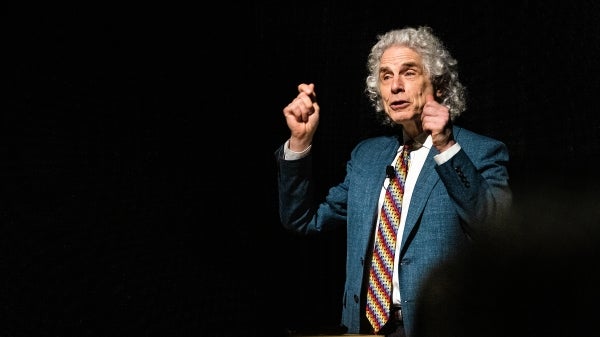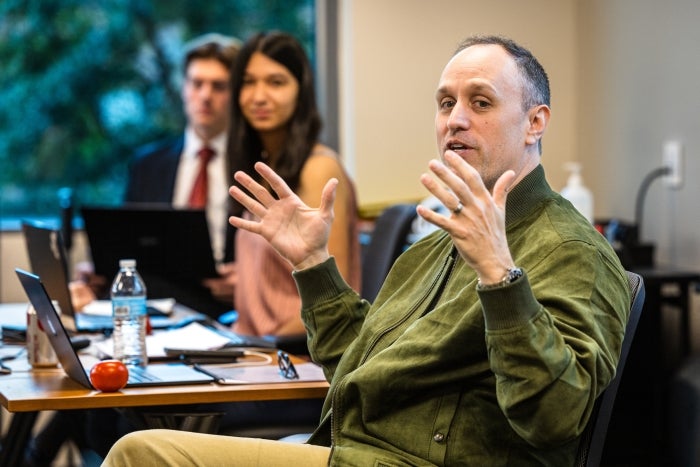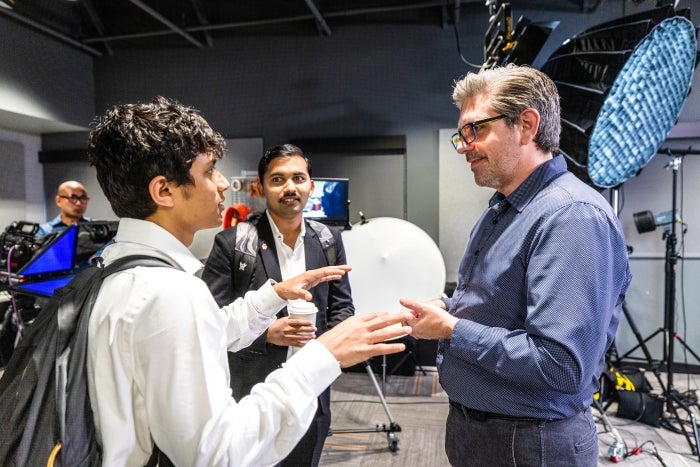When is a tomato more than a tomato? Crow guides class to a wider view of technology

ASU President Michael Crow teaches a graduate-level course titled "Science, Technology and Public Affairs" every spring semester. On the first day of class Jan. 15, he used a tomato as an example of how humans have manipulated the environment to improve their lives for thousands of years. Photo by Charlie Leight/ASU News
How is a tomato a type of technology?
Arizona State University President Michael Crow stood in front of a classroom full of students, holding up a tomato.
“This object does not exist in nature,” he told them.
For these students, Crow was not just the university president. He was their professor as he led them through the tomato-as-technology exploration — how it was originally a small fruit in South America, then was genetically modified by humans to be larger and sturdier for machine harvesting, how universities do the crucial agriculture research that the free market has no profit incentive to undertake, and why the federal government ensures the safety of the food supply in the U.S.
“Can the market ensure the delivery of the food supply in all circumstances? No, it cannot,” Crow told the students.
“The role of the government is often to intervene in areas where the market can't provide the outcome that the broader society would want.”
Public Affairs 547 is a graduate-level course titled “Science, Technology and Public Affairs.” Crow created the course when he was at Columbia University and has taught it at ASU since he arrived in 2002. For the past few years, he has co-taught with Derrick Anderson, an associate professor in the School of Public Affairs and senior vice president of Education Futures, a division of the American Council on Education.
“This class is built on the premise of how to design the future,” Crow told the group, most of whom were graduate students, though the course is also open to undergraduates in Barrett, The Honors College.
“How do you decide what to do about your science and technology future? How do you make decisions about where you want society to go?” he asked them.
Fittingly, the course is infused with technology. Students are constantly researching on their laptops and exhorted to use artificial intelligence for assistance. They can access a podcast generated by AI using the course content. And the capstone is a Crash Course-style YouTube video.
Cecilia Alcantar-Chavez, a graduate student in the Thunderbird School of Global Management, is one of two teaching assistants for the class, along with Zachary Van Tol, a PhD student in the School of Sustainability. She said the course, which she took in 2022 as an undergraduate, challenges how students think about technology and government.
“We talk about how people think companies will solve all the problems. But people forget that you're able to turn on your water and not get poisoned because there's government there, there's the correct infrastructure,” she said.
“And the design sets the trajectory for not only technology but institutions as well.”
Later in the class, Crow held up an iPhone.
“The purpose of the class is to get you to look at an object like this and see it as something other than Steve Jobs' creation," he said. "It is the product of a democracy, making decisions about what it is that we want to be.”
Training scholars for impact
Anderson, who earned bachelor’s and master’s degrees from ASU, took “Science, Technology and Public Affairs” in the early 2000s. Inspired by ASU’s Crash Course partnership, he added the video capstone when he began co-teaching in 2020.
Now, the course’s YouTube channel has more than 40 videos on topics such as algae biofuels as a renewable energy, carbon-capture and carbon-removal technology, the connection between heat pumps and geopolitics, and fitness wearables.
“When you start breaking it apart, thinking about what it takes to produce that content, you realize that it's a highly sophisticated form of communication,” Anderson said.
“And I quickly started to reflect on my own biases as a professor and my preferred mode of communication being the journal article or the book. And I realized that a very low-impact YouTube video has more views than some of the best academic journal articles that have ever been written.
“I have an obligation to start training the next generation of scholars in a form of content production and communication that is associated with greater impact than what I was raised to do as a scholar myself.”
In 2023, Anderson started having the class work with the Instructional Design and New Media team at EdPlus, which partners with professors to develop engaging online course content.
Matthew Robinson, director of new media at EdPlus, gave the class tips on how to make a Crash Course-style video. He suggested they choose one of three popular formats: a news report shot in front of a green screen, a talk show where two people converse back and forth, or a direct address to the camera.
“You’re spending your time and your energy on the information and how you're structuring it — not on the wild ideas people get when they hear ‘green screen,’” he told them.
Students also have access to the Hayden Library Makerspace and the Zoom Innovation Lab.
Throughout the semester, the students get feedback on their projects before presenting the final six- to seven-minute videos to the class at the end.
Alcantar-Chavez and her classmate created a video describing the technology of small nuclear reactors.
“The hardest part is putting together the script and having so much information in so few words,” she said.
She helps the student teams refine the video postings for YouTube, with descriptions and thumbnail images that are optimized for search engines.
“These are very driven individuals, so it always turns out great,” she said.
Anderson told the class that the concepts they learn will be useful in any career.
As senior vice president in the American Council on Education, Anderson advises the Department of Defense, the Department of Education and members of Congress.
“I’m involved in the work of institutional design, and so is Dr. Crow,” he said.
“These ideas we have in class seamlessly integrate into the work that I do on a daily basis.”
More Science and technology
ASU Interplanetary Lab celebrates 5 years of success
Five years ago, an Arizona State University student came up with the idea of creating a special satellite in what was then the newly built Interplanetary Laboratory. The idea was to design…

ASU secures NSF grant to advance data science literacy as demand soars
In an era where data permeates every facet of our lives, the importance of data literacy cannot be overstated. Recognizing this critical need, Jennifer Broatch, a professor at Arizona State…

Popular science author Steven Pinker explores rationale behind irrational thinking at ASU event
Popular science author Steven Pinker returned to Arizona State University’s Tempe campus on Feb. 7 for a rational talk about irrational thinking.More than 200 people filled Marston Exploration…

